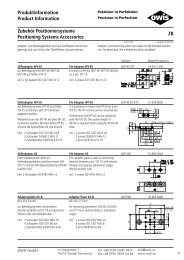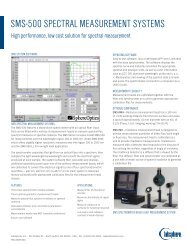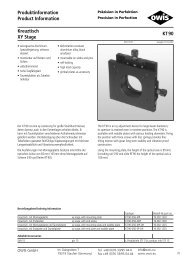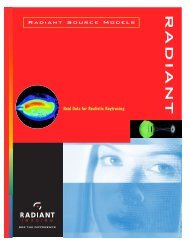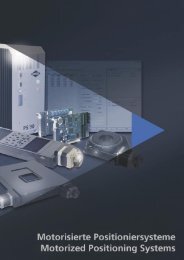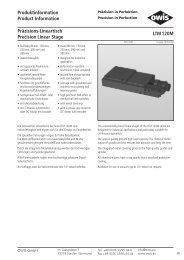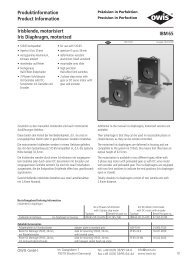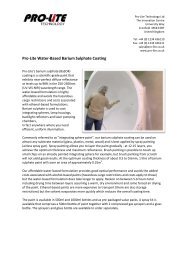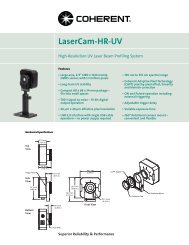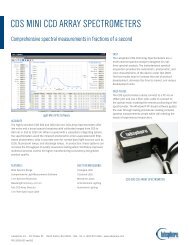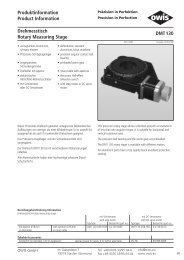Choosing the Right Sphere Size for Your Application - Labsphere
Choosing the Right Sphere Size for Your Application - Labsphere
Choosing the Right Sphere Size for Your Application - Labsphere
Create successful ePaper yourself
Turn your PDF publications into a flip-book with our unique Google optimized e-Paper software.
Comparison of <strong>Sphere</strong> Accessories150 mm Diameter Integrating <strong>Sphere</strong>ADVANTAGESAvailability• Available <strong>for</strong> high-end, double beam spectrophotometers.Port Fraction• Low port fraction—typically 2–4%. Meets CIE color measurementspecifications.Measurement Accuracy• Highest measurement accuracy is achieved with large integratingspheres since sphere errors can be minimized, resulting in veryhomogeneous light flux and minimal hot spots in sphere.Substitution Errors• Double beam integrating spheres—no sample substitution errors.Sample Beam <strong>Size</strong>• Large sample beam size—good coverage of inhomogeneous samples.Design Options/Description• Accessory is more flexible—can accommodate various sphere designssuch as center mount sample holder, small spot optics, or downwardviewing reflectance port.• External compartment accessory—can measure reflectance of largesamples using <strong>the</strong> external ports with removable covers.• More room to design custom sample holders <strong>for</strong> reflectance ortransmittance samples—not limited by size of spectrophotometer’ssample compartment.• Uses sensitive PMT (200–850 nm) and PbS (850–2500 nm)detectors.LIMITATIONSAvailability• Not available <strong>for</strong> many moderately priced single or dual beamspectrophotometers.<strong>Sphere</strong> efficiency• Not as efficient as smaller spheres—large sphere diameter attenuates<strong>the</strong> sample beam energy more than a small sphere of similar design.Noise Level• Signal-to-noise may be lower <strong>for</strong> highly absorbing samples (mayhave to per<strong>for</strong>m scans at larger slit widths, slower scan speeds, orwith reference beam attenuation to compensate).Sample Beam <strong>Size</strong>• Large sample beam spot size overfills small test samples, requiringmasking or small spot kits which lead to additional energy loss.Design Options/Description• Out-of-compartment accessory—may be subject to stray light effects.• Often more difficult to use—may be harder to install, optical alignmentmay be more complicated.• Usually cannot be equipped with silicon photodiode (200–1100 nm)detector.Cost• More expensive (more optics, typically two detectors and preamplifierboards).60 mm Diameter Integrating <strong>Sphere</strong>ADVANTAGESAvailability• Available <strong>for</strong> moderately priced single, dual, and double beamspectrophotometers.<strong>Sphere</strong> efficiency• Smaller spheres are more efficient collectors—in general, more energyreaches detector.Noise Level• Higher throughput systems, <strong>the</strong>re<strong>for</strong>e signal-to-noise is usuallybetter, especially <strong>for</strong> highly absorbing samples (Note—also dependson linearity range of instrument).Sample Beam <strong>Size</strong>• Smaller sample beam spot size better matches small test samples, noneed to mask or use small spot kits which lead to throughput loss.Design Options/Description• In compartment accessory—generally not subject to light leaks.• Simple to use—easy to install and remove accessory (once electronicsare in place, if applicable), optical alignment is more straight<strong>for</strong>ward.• Accessories with small spheres can be equipped with ei<strong>the</strong>r PMT(200–850 nm) or silicon photodiode (200–1100 nm) detectors,depending on spectrophotometer.Cost• Less expensive (fewer optics, typically one detector only).LIMITATIONSAvailability• Often not available <strong>for</strong> high-end, double beam spectrophotometers.Port Fraction• High port fraction—typically above 10%. <strong>Sphere</strong> does not meet CIEcolor measurement specifications.Measurement Accuracy• <strong>Sphere</strong> errors or hot spots may occur in small spheres—errors maynot be completely corrected by a sphere’s baffles due to space constraints,which often prohibit placement of correctly sized baffles intoa small sphere’s interior.Substitution Errors• Small integrating spheres on single or dual beam spectrophotometersare subject to sample substitution errors, which can approach 10%R<strong>for</strong> diffuse samples.Sample Beam <strong>Size</strong>• Small sample beam size means multiple locations must be measuredon inhomogeneous samples.Design Options/Description• Accessory design is less flexible—cannot accommodate special spheredesigns such as center mount sample holder or downward viewingreflectance port.• Cannot measure reflectance or transmittance of extremely largesamples inside <strong>the</strong> spectrophotometer’s sample compartment.• Limited ability to design custom sample holders <strong>for</strong> reflectance ortransmittance samples—limited by size of sample compartment.6



